
| HOME | SEARCH | ABOUT US | CONTACT US | HELP | ||
| |
| This is an obsolete version of the rule. Please click on the rule number to view the current version. | |||||||||
|
17.50.708 SAMPLING AND ANALYSIS PLAN (1) The owner or operator or their consultant shall prepare or have prepared a sampling and analysis plan (SAP) for use during all ground water sampling activities in and around the facility. The SAP shall include: (a) a sampling plan including: (i) objectives; (ii) schedules and task assignments; (iii) access (if off-site sampling is done) ; (iv) sampling procedures, including: (A) sample acquisition methods; (B) locations and ID numbers (map) ; (C) the order of sample collections: (I) by well location or sampling point number; and (II) according to required analytical parameter/chemical constituent analyses; (D) sampling objectives: (I) normal monitoring samples; and (II) samples to determine the nature and extent of contamination; (E) quality assurance/quality control (QA/QC) samples; (F) shipping and handling arrangements; (G) notification procedures to allow the department the opportunity to obtain split sampling; and (H) analytical parameters, including: (I) Table 1 parameters; (II) laboratory and analytical methods, according to approved US EPA method numbers, including practical quantitation limits and detection limits; (III) sample containers preservation and holding times; and (IV) laboratory-generated QA/QC samples. (v) list of supplies and equipment; and (b) a QA/QC plan, including: (i) field QA/QC methods: (A) standard operating procedure for field sampling methods; (B) field documentation methods; (C) frequency of QA/QC samples: (I) duplicates; and (II) blanks. (D) field instrument calibration; (E) chain of custody procedures; (ii) laboratory quality assurance/quality control (QA/QC) program: (A) laboratory identification; (B) sample custody; (C) analytical turn-around time; (D) calibration procedures and frequency; (E) data reduction, validation, and reporting; (F) internal quality control checks; (G) performance system and audits; and (H) specific procedures for routine assessment of data precision, accuracy and completeness. (c) if sampling contaminated ground water, a health and safety plan, including: (i) level of protection; (ii) hazard evaluation; (iii) ground water characteristics; (iv) special site considerations; (v) emergency information; (vi) decontamination procedures, including: (A) disposal of water from sampling effort; and (B) equipment and personnel decontamination. (2) The SAP must be submitted to the department prior to any ground water sampling and shall be implemented as modified and approved in writing by the department. (3) Requests for revisions to the SAP will be submitted to the department by the owner or operator of a facility. The department may approve, deny or modify revisions to the SAP. (4) (a) Once established at a disposal unit, ground water monitoring must be conducted throughout the active life and post-closure care period of that disposal unit as specified in ARM 17.50.531. The minimum ground water sampling frequency must be twice per year, at least 3 months apart, at high and low ground water periods, unless otherwise specified in writing by the department. The high and low water ground water level periods will be determined through first year monthly water level measurements. The direction of ground water flow must be determined each time ground water elevations are measured. The rate of ground water flow must be determined each time a well is sampled. (b) The department may specify an appropriate alternative frequency for repeated sampling and analysis during detection monitoring for Table 1 constituents, or the alternative list approved in accordance with (8) of this rule, during the active life (including closure) and the post-closure care period. The alternative frequency during the active life (including closure) must be no less than annual. The alternative frequency shall be based on consideration of the following factors: (i) lithology of the aquifer and unsaturated zone; (ii) hydraulic conductivity of the aquifer and unsaturated zone; (iii) ground water flow rates; (iv) minimum distance between the upgradient edge of the MSWLF unit and the downgradient monitoring well screen (minimum distance of travel) ; and (v) resource value of the aquifer. (5) Static water level elevation must be measured and (6) A copy of the approved sampling plan shall be kept at the facility or at the office of the facility owner and a field copy shall be provided to the sampling personnel for use during sampling. The sampling plan shall be followed unless a modification to the plan is approved in writing by the department. (7) The following field parameters will be measured following well purging during each ground water monitoring event: (a) pH; (b) specific conductivity; (c) static water elevation prior to purging; and (d) temperature. (8) (a) Unless otherwise specified in writing by the department the parameters listed herein as Table 1 must be monitored in the detection monitoring program. (b) The department may delete any of the Table 1 constituents required under detection monitoring if it can be demonstrated that the removed constituents are not reasonably expected to be in or derived from the waste contained in the unit. (c) The department may establish an alternative list of inorganic indicator parameters for a Class II unit, in lieu of some or all of the inorganic constituents listed in Table 1 (items 1-24) , or some or all of the Table 1 constituents at Class IV units, if the alternative parameters provide a reliable indication of releases from the unit to the ground water. In determining alternative parameters, the department shall consider the following factors: (i) the types, quantities, and concentrations of constituents in waste managed at the unit; (ii) the mobility, stability, and persistence of waste constituents or their reaction products in the unsaturated zone beneath the unit; (iii) the detectability of indicator parameters, waste constituents, and reaction products in the ground water; and (iv) the concentration or values and coefficients of variation of monitoring parameters or constituents in the ground water background. (9) Analysis of the parameters listed in Table 1 must be conducted by an analytical laboratory that will follow the analytical methods referenced in EPA's "Methods for Chemical (10) The owner/operator must establish background ground water quality in a hydraulically upgradient or background well(s) for each of the monitoring parameters and constituents required according to Table 1 of this rule if detection monitoring is required or Table 2 of this rule if assessment monitoring is required. Background ground water quality may be established at wells that are not located hydraulically upgradient from the disposal unit if any of the following conditions exist: (a) hydrogeologic conditions do not allow the owner/operator to determine what wells are hydraulically upgradient; (b) physical obstacles preclude installation of an upgradient background monitoring well location; or (c) sampling at other well will provide an indication of background quality that is representative or more representative than that provided by the upgradient wells. (11) The number of samples collected to establish ground water quality data must be consistent with the appropriate statistical procedures determined in (12) of this rule. Sampling procedures will be those specified in (1) (a) (iv) of this rule. (12) The owner or operator must use 1 of the following statistical methods in evaluating ground water monitoring data for each hazardous constituent, use the method chosen separately for each hazardous constituent in each well, and specify in the operating record and to the department which method will be used: (a) A parametric analysis of variance (ANOVA) followed by multiple comparisons procedures to identify statistically significant evidence of contamination, including estimation and testing of the contrasts between each compliance well's mean and the background mean levels for each constituent. (b) An analysis of variance (ANOVA) based on ranks followed by multiple comparisons procedures to identify statistically significant evidence of contamination, including estimation and testing of the contrasts between each compliance well's median and the background median levels for each constituent. (c) A tolerance or prediction interval procedure in which an interval for each constituent is established from the distribution of the background data, and the level of each constituent in each compliance well is compared to the upper tolerance or prediction limit. (d) A control chart approach that gives control limits for each constituent. (e) Another statistical test method that meets the performance standards of (13) of this rule. The owner or operator must place a justification for this alternative in the operating record and notify the department of the use of this alternative test. The justification must demonstrate that the alternative method meets the performance standards of (13) of this rule. (13) Any statistical method chosen under (12) of this rule shall comply with the following performance standards, as appropriate: (a) The statistical method used to evaluate ground water monitoring data must be appropriate for the distribution of chemical parameters or hazardous constituents. If the distribution of the chemical parameters or hazardous constituents is shown by the owner or operator to be inappropriate for a normal theory test, then the data must be transformed or a distribution-free theory test must be used. If the distributions for the constituents differ, more than one statistical method may be needed. (b) If an individual well comparison procedure is used to compare an individual compliance well constituent concentration with background constituent concentrations or a ground water protection standard, the test must be done at a Type I error level no less than 0.01 for each testing period. If a multiple comparisons procedure is used, the Type I experiment wise error rate for each testing period must be no less than 0.05; however, the Type I error of no less than 0.01 for individual well comparisons must be maintained. This performance standard does not apply to tolerance intervals, prediction intervals, or control charts. (c) If a control chart approach is used to evaluate ground water monitoring data, the specific type of control chart and its associated parameter values must be protective of human health and the environment. The parameters must be determined after considering the number of samples in the background data base, the data distribution, and the range of the concentration values for each constituent of concern. (d) If a tolerance interval or a predictional interval is used to evaluate ground water monitoring data, the levels of confidence and, for tolerance intervals, the percentage of the population that the interval must contain, must be protective of human health and the environment. These parameters must be determined after considering the number of samples in the background data base, the data distribution, and the range of the concentration values for each constituent of concern. (e) The statistical method shall account for data below the limit of detection with 1 or more statistical procedures that are protective of human health and the environment. Any practical quantitation limit (PQL) that is used in the statistical method must be the lowest concentration level that can be reliably achieved within specified limits of precision and accuracy during routine laboratory operating conditions that are available to the facility. (f) If necessary, the statistical method shall include procedures to control or correct for seasonal and spatial variability as well as temporal correlation in the data. (14) The owner or operator must determine whether or not there is a statistically significant increase over background values for each parameter or constituent required in the particular approved ground water monitoring program that applies to the disposal unit. (a) In determining whether a statistically significant increase has occurred, the owner or operator must compare the ground water quality of each parameter or constituent at each monitoring well designated pursuant to ARM 17.50.706(2) to the background value of that constituent, according to the statistical procedures and performance standards specified under (12) and (13) of this rule. (b) Within 15 days after completing sampling and analysis, the owner or operator must determine whether there has been a statistically significant increase over background at each monitoring well. (15) Field records of all monitoring activities must be prepared in sufficient detail to document whether the ground water sampling plan has been followed. The facility owner or operator shall retain all field sampling records in the operating record for the active life and post-closure care periods of all Class II disposal units at the facility. The field records must be available for department and public inspection on request. The owner or operator shall submit sampling results and water elevation data within 90 days after sampling. A report describing any deviations from the approved sampling plan or analytical procedures must be submitted at the same time and placed in the operating record. (16) (a) The department hereby adopts and incorporates by reference: (i) EPA's "Methods for Chemical Analysis of Water and Wastes", (EPA-600) ; and (ii) EPA's "Test Methods for Evaluating Solid Waste, Physical/Chemical Methods", (SW-846) , third edition, September, 1986. (b) Both of the above documents prescribe standards for testing water for certain parameters. Copies may be obtained from the Department of Environmental Quality, PO Box 200901, Helena, MT 59620-0901 [(406)444-1430].
(see next page for table) TABLE 1 - GROUND WATER MONITORING PARAMETERS
25. The following volatile organic compounds (VOCs by EPA method 8260) :
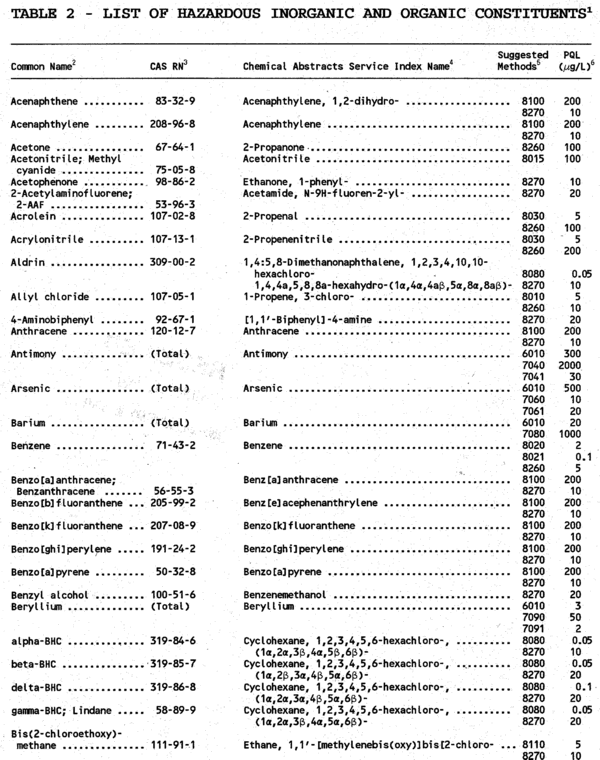
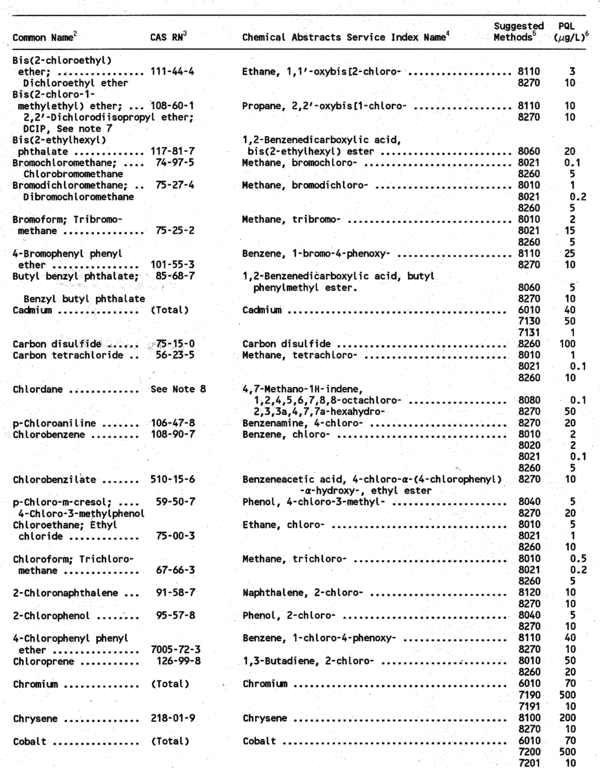
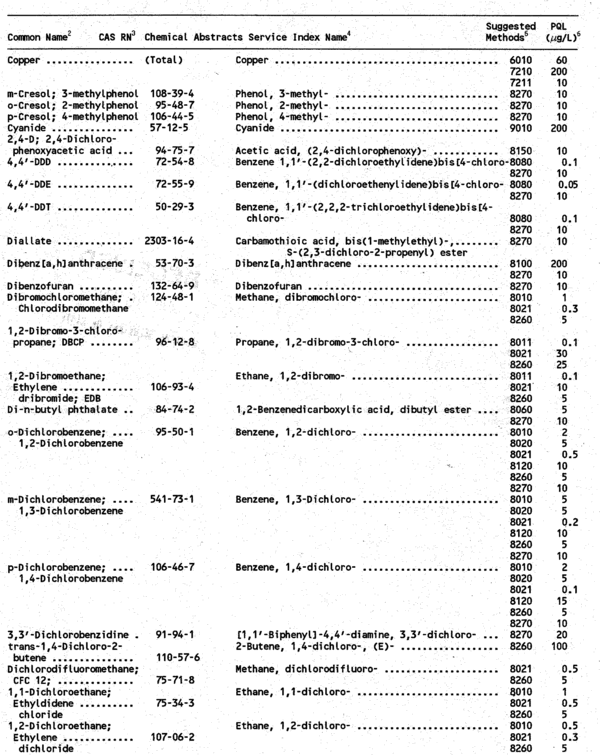
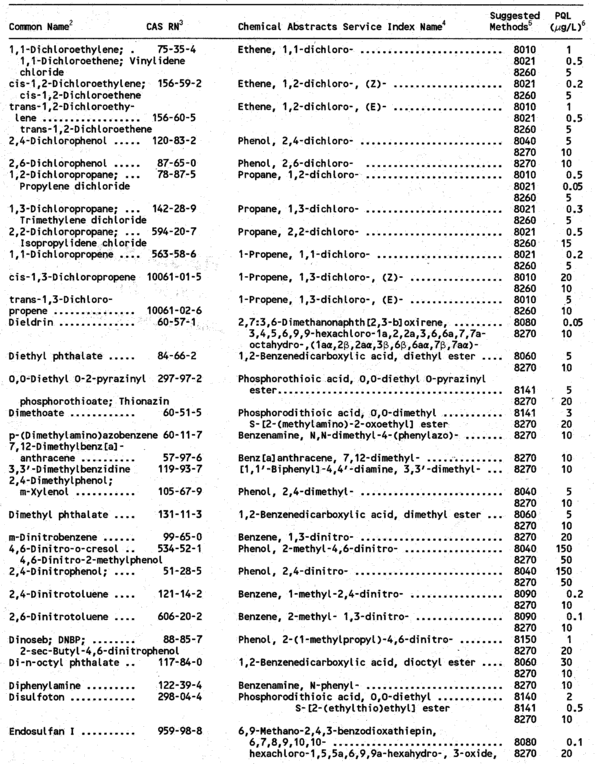
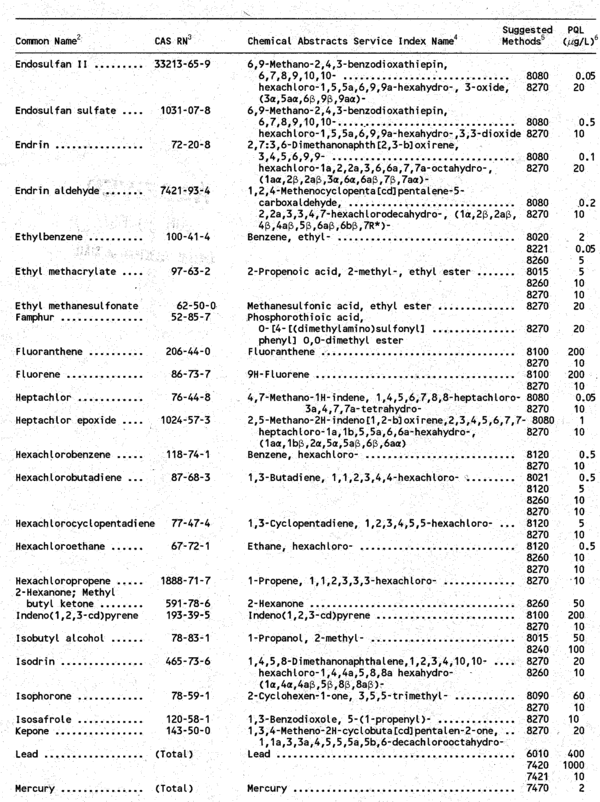
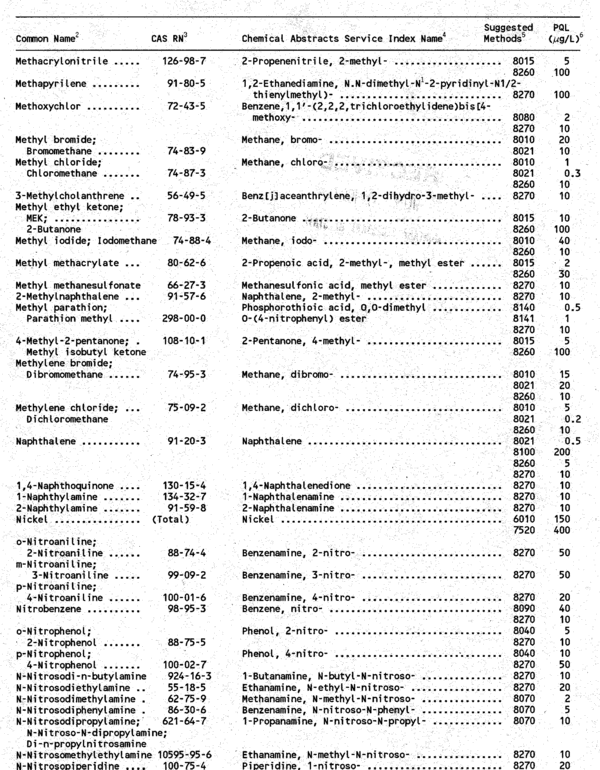
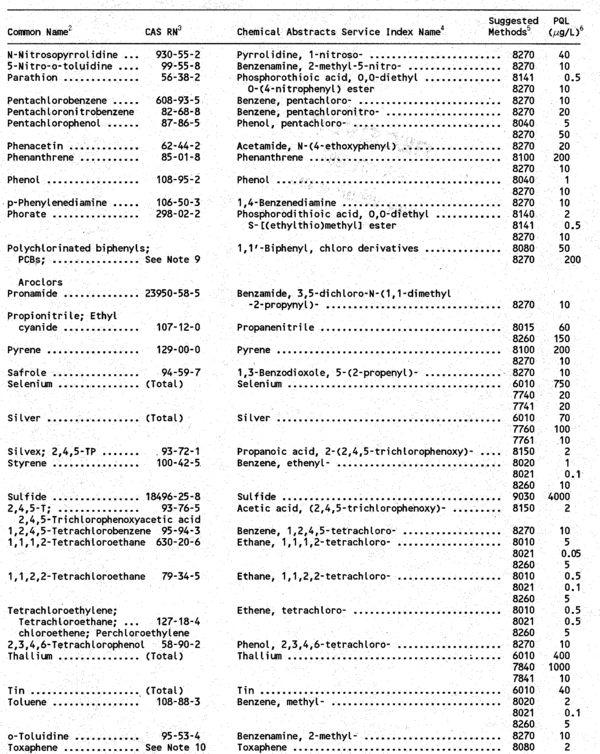
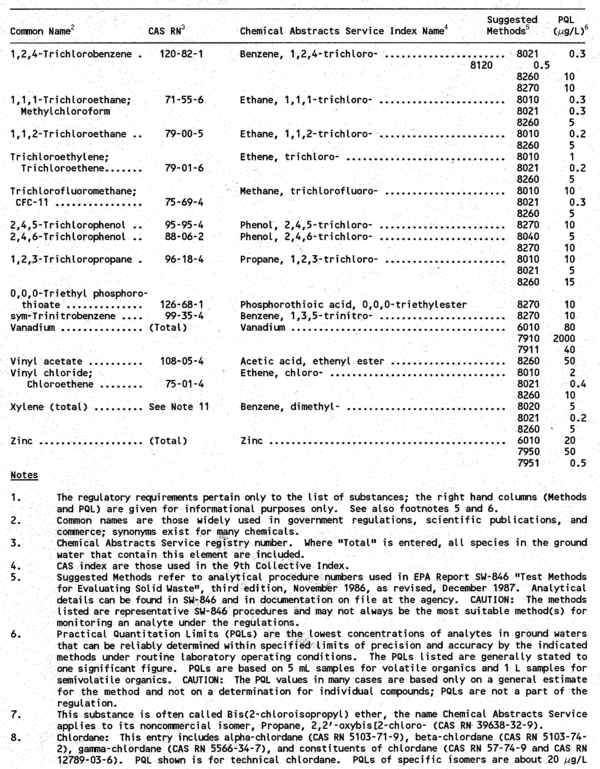 by method 8270. by method 8270.
9. Polychlorinated biphenyls (CAS RN 1336-36-3) ; this category contains congener chemicals, including constituents of Aroclor 1016 (CAS RN 12674-11-2) , Aroclor 1221 (CAS RN 11104-28-2) , Aroclor 1232 (CAS RN 11141-16-5) , Aroclor 1242 (CAS RN 53469-21-9) , Aroclor 1248 (CAS RN 12672-29-6) , Aroclor 1254 (CAS RN 11097-69-1) , and Aroclor 1260 (CAS RN 11096-82-5) . The PQL shown is an average value for PCB congeners. 10. Toxaphene: This entry includes congener chemicals contained in technical toxaphene (CAS RN 8001-35-2) , i.e., chlorinated camphene. 11. Xylene (total): This entry includes o-xylene (CAS RN 96-47-6) , m-xylene (CAS RN 108-38-3) , p-xylene (CAS RN 106-42-3) , and unspecified xylenes (dimethylbenzenes) (CAS RN 1330-20-7). PQLs for method 8021 are 0.2 for o-xylene and 0.1 for m- or p-xylene. The PQL for m-xylene is 2.0 µg/L by method 8020 or 8260. History: 75-10-204, MCA; IMP, 75-10-207, MCA; NEW, 1991 MAR p. 1937, Eff. 10/18/91; AMD, 1993 MAR p. 1645, Eff. 10/9/93; AMD, 1993 MAR p. 2784, Eff. 11/25/93; TRANS, from DHES, 1995 MAR p. 2253; AMD, 1997 MAR p. 1031, Eff. 6/24/97. |
A directory of state agencies is available online at http://www.mt.gov/govt/agencylisting.asp.
For questions about the organization of the ARM or this web site, contact sosarm@mt.gov.